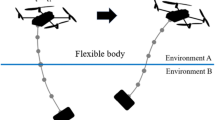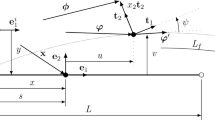Abstract
This paper proposes a modeling technique which is able to not only reliably and easily represent the hysteretic characteristics but also analyze the dynamic stress of a taper leaf spring. The flexible multi-body dynamic model of the taper leaf spring is developed by interfacing the finite element model and computation model of the taper leaf spring. Rigid dummy parts are attached at the places where a finite element leaf model is in contact with an adjacent one in order to apply contact model. Friction is defined in the contact model to represent the hysteretic phenomenon of the taper leaf spring. The test of the taper leaf spring is conducted for the validation of the reliability of the flexible multi-body dynamic model of the taper leaf spring developed in this paper. The test is started at an unloaded state with the excitation amplitude of 1–2 mm/sec and frequency of 132 mm. First, the simulation is conducted with the same condition as the test. Then, the simulations are conducted with various amplitudes in a loaded state. The hysteretic diagram from the test is compared with the ones from the simulation for the validation of the reliability of the model. The dynamic stress analysis of the taper leaf spring is also conducted with the developed flexible multi-body dynamic model under a dynamic loading condition.
Similar content being viewed by others
References
Antoun, R. J., Hackert, P. B., O’Leary, M. C. and Sitchin, A., 1986, “Vehicle Dynamic Handling Computer Simulation — Model Development, Correlation and Application Using ADAMS,” SAE Technical Paper.
Chen, M., Chen, L., Zhang, X., Bai, H. and Xian, Y., 2003, “Research and Dynamic Simulation of Docking Locks with Contact-Impact,”Aerospace Science and Technology, Vol. 7, Issue 5, pp. 364–372.
Dassault Systems, 1998, “CATIA V4 Manuals,” IBM CATIA Training Center.
Judd, E. H., 1990, “Spring Design Manual,”Society of Automotive Engineer, Inc., 400 Commonwealth Drive, Warrendale.
Kim, D. W. and Lim, J. H., 1996, “A Study on Improving Ride Quality of the Commercial Vehicle,”J. of the KSAE, Vol. 4, No. 6, pp. 229–235
MSC. ADAMS, 2001, “ADAMS User’s Manual,”MacNeal-Schwendler, Inc., Oakdale, IA, U.S.A.
MSC. NASTRAN User’s Manual, 1994, MacNeal-Schwendler Corporation, U.S.A.
MSC. PATRAN User’s Manual, 1994, MacNeal-Schwendler Corporation, U.S.A.
Moon, I. D. and Oh, C. Y., 2004, “Modeling of a Multi-Leaf Spring for Dynamic Characteristics Analysis of a Large Truck,”J. of KSPE, Vol. 21, No. 10, pp. 147–153.
SAE HD788, 1990, “Design and Application of Leaf Spring”.
Song, J. and Maruyama, Y., 1993, “Dynamic Characteristics of Leaf Spring by ADAMS Software,”Japan Society of Spring Engineers, Vo. 38, pp. 31–36.
Yamamoto, E., Hamano, T., Enomoto, H. and Numazaki, I., 1995, “Characteristic of Hysteresis Curve of the Leaf Spring,”ISUZE Advanced Engineering Center Ltd, SAE 9530751.
Author information
Authors and Affiliations
Corresponding author
Rights and permissions
About this article
Cite this article
Moon, ID., Yoon, HS. & Oh, CY. A flexible multi-body dynamic model for analyzing the hysteretic characteristics and the dynamic stress of a taper leaf spring. J Mech Sci Technol 20, 1638–1645 (2006). https://doi.org/10.1007/BF02916267
Received:
Revised:
Issue Date:
DOI: https://doi.org/10.1007/BF02916267




